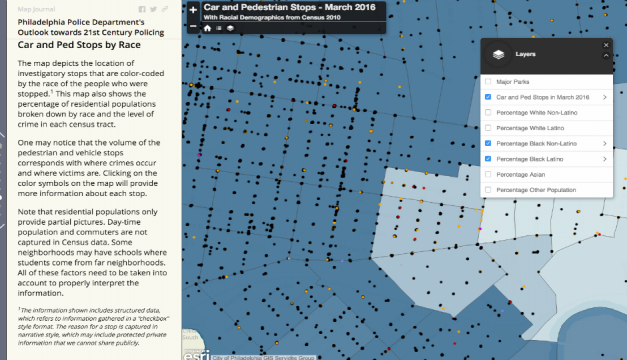The Philly Police Want You To Dig Through Their Data

A glimpse at car and pedestrian stops conducted by Philly cops earlier this year.
Transparency, transparency and more transparency — that’s what people want from law enforcement in this post-Ferguson world.
The Philadelphia Police Department took a big step forward on that front last week by releasing a ton of information on violent crime, police-involved shootings and stop-and-frisk across the city as part of the Obama administration’s Police Data Initiative.
If you’re the kind of person who normally starts to zone out at the mention of data and charts, hang on. This is worth checking out, because we’re not that far removed from a time when this sort of information wasn’t readily available to the public. “The process had been one whereby you put in a request, and who knows how long it took to get that information, or if it was still relevant by the time you got it,” said Scott Charles, the Trauma Outreach Coordinator for Temple University Hospital. “Now it’s at your fingertips.”
Charles, who also serves as the co-director of Temple’s Cradle to Grave program, didn’t hesitate to start exploring the information the department released, which you can find on the OpenDataPhilly website. He tweeted a sobering snapshot of the city’s shooting victims in 2015:
https://twitter.com/TheScottCharles/status/725101140686311429
Temple’s trauma experts have been venturing into violence-plagued neighborhoods to teach residents how to help gunshot victims survive until paramedics arrive as part of the hospital’s “Fighting Chance” program. The quality of the newly-released violent crime data, which will be updated quarterly, can give Temple a clearer idea of where it needs to be focusing its efforts. “This has huge possibilities when it comes to violence prevention,” Charles said.
The data that will likely draw the most interest centers on police-involved shootings and pedestrian stops. (There’s a 14-day delay on information about police shootings being posted online.) The police department has been collecting data on stop-and-frisk incidents ever since it entered into a consent decree with the American Civil Liberties Union in 2011, glimpses of which have been released in annual reports. The department has also been regularly posting information about police-involved shootings on its website. But this is different.
The data is laid out in a map journal that allows users to learn more than just where pedestrians are stopped or frisked; you can also see how those neighborhoods break down according to race, crime and poverty. “The way this data was released was, for me, like a dream come true,” said Tim Wisniewski, the city’s Chief Data Officer. “It’s the best contextualization of government data that I’ve seen.”
The end result isn’t shocking — the vast majority of stops and frisks occur in African-American and Latino neighborhoods where most residents are weighed down by poverty and gun violence. The hope is that this data will both hold police more accountable, and spark new ideas on how to address these long-running problems.
“This has been a big part of the open government movement,” said Kevin Thomas, the the director of the Police Department’s Research and Analysis Unit. “By releasing this information and providing it to people who have skills in statistical analysis, they can look at it and find patterns and stories inside the data that maybe we aren’t aware of. Perhaps there’s something we can learn from a 9th grade coder who’s looking at it with outside perspective.”
Thomas is himself an outsider, a civilian with a background in data who was hired by the department in 2013. At the time, the city was still relatively new to the process of releasing digital stockpiles of information. Then-Police Commissioner Charles Ramsey, who co-chaired Obama’s Task Force on 21st Century Policing, was on board with the overall idea of making internal data public, but this particular release was signed off on by Police Commissioner Richard Ross, Thomas said.
Thomas’s and Wisniewski’s teams worked to scrub the data of personal information about gunshot victims or those stopped by police, and make it easily digestible for the public.
“People feel a responsibility to keep the government accountable, and people inside the government are aware of that,” Wisniewski said. “We’ve always talked about providing some kind of narrative to the data, and that’s what makes the map journal so perfect. You can drag your cursor over and see how the crime patterns line up with other information. It’s a learning moment.”
Follow @dgambacorta on Twitter.